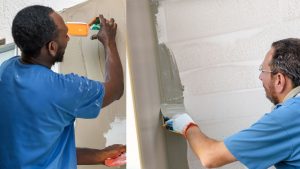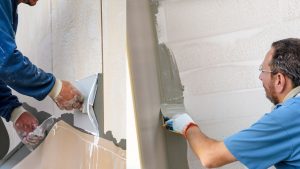How to Waterproof Your Basement from the Outside

Introduction
Water leakage in basements can be a frustrating and costly problem for homeowners. Moisture seeping through the foundation walls can lead to mold growth, structural damage, and a damp living environment. One effective way to address this issue is by waterproofing your basement from the outside. In this article, we will guide you through the steps and techniques required to protect your basement from water infiltration. By following these methods, you can ensure a dry and secure basement that will withstand the test of time.
Outline
- Introduction
- Common Causes of Basement Water Leakage
- Importance of Exterior Waterproofing
- Assessing the Exterior of Your Basement
- Repairing Foundation Cracks
- Applying Waterproofing Membrane
- Installing Drainage Systems
- Landscaping Considerations
- Maintenance and Inspection
- Advantages of Exterior Waterproofing
- Conclusion
- FAQs

Common Causes of Basement Water Leakage
Before delving into the process of waterproofing your basement from the outside, it’s important to understand the common causes of water leakage. This knowledge will help you identify potential problem areas and take appropriate action. Some common causes include:
-
Poorly sealed foundation walls:
When the foundation walls are not adequately sealed, water can seep through cracks and gaps.
-
Hydrostatic pressure:
Excessive groundwater around the foundation can create hydrostatic pressure, forcing water through the walls and into the basement.
-
Improper drainage:
Insufficient or malfunctioning drainage systems can lead to water pooling around the foundation, increasing the risk of leakage.
Importance of Exterior Waterproofing
Exterior waterproofing is a proactive approach that addresses the root causes of basement water leakage. By treating the exterior foundation walls, you can prevent water from entering the basement in the first place. This method provides long-term protection and offers several benefits, including:
- Preserving structural integrity: Exterior waterproofing safeguards the foundation walls, preventing cracks and structural damage caused by water infiltration.
- Preventing mold and mildew: By keeping the basement dry, you reduce the risk of mold and mildew growth, which can negatively impact indoor air quality and pose health hazards.
- Protecting belongings: Waterproofing from the outside ensures that your stored items, furniture, and other belongings in the basement remain safe and dry.
- Increasing property value: A waterproofed basement is an attractive feature for potential buyers, increasing the value of your property.
Assessing the Exterior of Your Basement
Before initiating the waterproofing process, it’s crucial to conduct a thorough assessment of the exterior of your basement. This will help you identify any existing issues and determine the appropriate solutions. Consider these factors during the assessment:
-
Inspect the foundation walls:
Look for visible cracks, gaps, or signs of water damage on the exterior walls of your basement. Take note of any areas that require repairs.
-
Check the grading:
Ensure that the soil around your foundation slopes away from the house. Proper grading directs water away from the basement, reducing the risk of water seepage.
-
Evaluate downspouts and gutters:
Always make sure your downspouts and gutters are functioning correctly. They should be directing water at least six feet away from the foundation to prevent water accumulation.
Repairing Foundation Cracks
Addressing foundation cracks is a crucial step in the waterproofing process. Even small cracks can allow water to penetrate the basement walls. Follow these steps to repair foundation cracks effectively:
- Clean the crack: Remove any loose debris, dirt, or vegetation from the crack using a wire brush or compressed air.
- Apply epoxy or polyurethane sealant: Fill the crack with a high-quality sealant that is designed for foundation repairs. Follow the manufacturer’s instructions for the application process.
- Allow the sealant to cure: Give the sealant ample time to cure and form a strong bond. This will ensure a durable repair that prevents water infiltration.

Applying Waterproofing Membrane
After repairing any foundation cracks, the next step is to apply a waterproofing membrane to the exterior walls of your basement. This membrane acts as a protective barrier, preventing water from penetrating the foundation. Here’s how to apply it:
- Clean the walls: Remove any dirt, debris, or loose material from the foundation walls using a stiff brush or power washer.
- Mix and apply the waterproofing coating: Always Follow the manufacturer’s complete instructions to mix the waterproofing coating. Apply it to the walls using a brush, roller, or sprayer. Ensure complete coverage and pay extra attention to vulnerable areas such as corners and joints.
- Allow the coating to dry: Give the waterproofing coating sufficient time to dry and cure. This will create a seamless and impermeable barrier against water intrusion.
Installing Drainage Systems
To further enhance the waterproofing of your basement, consider installing drainage systems that will effectively redirect water away from the foundation. The two primary types of drainage systems are:
- French drains: French drains consist of a perforated pipe surrounded by gravel. They are installed along the perimeter of the foundation to collect and redirect groundwater.
- Exterior footing drains: These drains are installed at the base of the foundation walls during construction. They help alleviate hydrostatic pressure and direct water away from the basement.
Consult with a professional contractor to determine the most suitable drainage system for your specific needs and property.
Landscaping Considerations
In addition to implementing effective drainage systems, proper landscaping techniques can play a crucial role in preventing water infiltration. Consider the following landscaping considerations:
- Grading: Ensure that the soil slopes away from the foundation to divert water away from the basement.
- Vegetation: Plant trees and shrubs at an appropriate distance from the foundation to prevent root intrusion and excessive moisture absorption.
- Downspout extensions: Install downspout extensions to redirect water at least six feet away from the foundation.
Maintenance and Inspection
After completing the exterior waterproofing of your basement, regular maintenance and inspection are essential to ensure its long-term effectiveness. Follow these guidelines:
- Clean gutters and downspouts: Regularly remove debris from gutters and downspouts to prevent blockages and ensure proper water flow.
- Inspect the exterior walls: Periodically check for any signs of damage, cracks, or deterioration on the exterior walls. Repair any issues promptly to maintain the integrity of the waterproofing system.
- Monitor drainage systems: Keep an eye on the performance of your drainage systems, including French drains and exterior footing drains. Clear any obstructions and ensure they are functioning correctly.
Advantages of Exterior Waterproofing
Exterior waterproofing offers numerous advantages over interior methods. Some key benefits include:
- Long-lasting protection: Exterior waterproofing addresses the root causes of water infiltration, providing durable protection against moisture.
- Preserves living space: Interior waterproofing methods can reduce the usable space in your basement. Exterior waterproofing ensures that your basement remains dry and functional.
- Prevents mold growth: By preventing water from entering the basement, you effectively eliminate the conditions required for mold and mildew growth.
- Enhances property value: A waterproofed basement adds value to your property and makes









